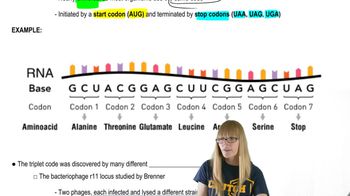Shown here is a hypothetical viral mRNA sequence:
5'-AUGCAUACCUAUGAGACCCUUGGA-3'
Assuming that it could arise from overlapping genes, how many different polypeptide sequences can be produced? What are the sequences?
 Verified step by step guidance
Verified step by step guidance Verified video answer for a similar problem:
Verified video answer for a similar problem:

